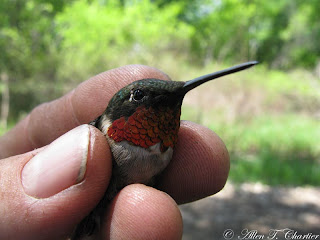Highlights of birds banded on Friday, May 28 included a female Ruby-throated Hummingbird. Always a highlight, this hummingbird was unusual in that she had a fairly noticeable amount of fat, which I rarely observe in spring, and her weight was 3.9 grams where about 3.2 to 3.4 would be a normal "non-fat" weight. Clearly, Ruby-throated Hummingbird migration is still ongoing in southern Michigan. Surprisingly, both the Downy Woodpecker and Northern Flicker were firsts for this spring season. A recaptured "Traill's" Flycatcher, probably one of the locally nesting Willow Flycatchers, was of interest as it was banded as a hatch-year on 2 August 2009; probably fledged locally. The flycatcher highlight, though, was this adult female Great Crested Flycatcher.
Her sex was determined by the presence of a brood patch, not visible in the field of course. Great Cresteds are not caught at Metro Beach every year, and in fact this appears to be the 23rd since 1989 (20 from 1989-2001, in both spring and fall), and only the third since 2004 (all in spring). An after hatch-year mal Tree Swallow recaptured in the Upland Nets for the second time this spring is obviously nesting in the area, and was banded in 2009 out at the Field Edge nets. A pair of Tree Swallows has taken ownership of the nest box put out by the Field Nets by Neil Gilbert in 2007 but they haven't been captured yet...perhaps they're familiar with the situation and are banded too. A singing male Wood Thrush in the area of the Swamp Nets was finally captured late in the day (sex verified by the presence of an enlarged cloacal protuberance). The wooded acreage in this park is probably very limiting for the nesting of Wood Thrushes, but it appears that he might be attempting to establish a territory, with or without a female.
The early warm spring, and continued mild conditions, have allowed for some species to succeed in raising young already. While nestling American Robins are being reported and found on the ground all over the Metro Detroit area now, this one captured today was fully-feathered and is probably independent of its parents. Last year, we caught the first juvenile robins on June 5-6 (four of them), so I expect that next week should find more of them in our nets.
As noted in a previous posting, European Starlings are not something that most banders would make the effort to band. But, the protocol for banding anything and everything caught at Metro Beach was set before I restarted the effort in 2004, so once again the starling caught today was banded. Not too many are captured, and although they are an introduced species, and harmful to some native birds, it does migrate so could give us some information on their movements. And, they're beautiful with their iridescence. Something that not many people, other than banders know, is that in the breeding season the sexes can be distinguished by a spot of color on the base of the lower mandible, blue in males pink in females. No kidding! Obviously, our bird today was a male.
Sometimes what birders see and what banders can determine are quite different. The Yellow Warbler in the photo below appears to have some chestnut streaks on the breast, which might suggest that it is a male to some birders (perhaps second-year as they're not particularly bold).
But examination of this individual's molt indicates that it is an after second-year bird, and further, checking under the feathers reveals a surprise. It is clearly a female as she is showing an extensive brood patch, and is clearly developing an egg in her abdomen.
Thanks to Tom Schlack for taking the photo above while I blew her feathers aside until I nearly passed out! A good number of Red-winged Blackbirds was banded today, making up somewhat for the ones we usually get in April, but missed this year.
Interesting birds observed today but not banded included two rather late Common Loons flying northeast off Lake St. Clair just at sunrise, a Blue-winged Teal calling softly from the swamp near the Upland Nets, and the continuing presence of Cooper's Hawks at their second nesting site after apparent failure at their first. Singing Eastern Wood-Pewee and Alder Flycatcher were of interest, as was both Red-eyed and Warbling Vireo. A Swainson's Thrush singing briefly and softly was the only species noted today that does not breed in southernmost Michigan.
Thanks to Jean Gramlich and Tom Schlack for helping out today in the heat, and beginning of mosquito season. Banding could not have been done today without you.
============================
Banding Data-------------------------------------
FRIDAY, May 28, 2010
Sunrise (E.S.T.): 5:00
Time Open (E.S.T.): 5:45
Time Closed (E.S.T.): 13:00
Hours Open: 7.25
No. of Nets: 4.25-13.25
Net Hours: 87.813
Temperature (F): 62-84
Cloud Cover: 10-0%
Wind: NW @ 3-7 mph
Barometer: 30.00-29.93
Precipitation: None
No. Banded: 36 (plus 22 recaptured and 2 released unbanded)
No. of Species: 18
Capture Rate: 68.3 birds per 100 net hours
Volunteers (worked 10.0 hours, 6:00-16:00): Jean Gramlich, Tom Schlack.
Ruby-throated Hummingbird - 1
Downy Woodpecker - 1
Northern Flicker - 1
"Traill's" Flycatcher - 1 (plus 1 recaptured)
Great Crested Flycatcher - 1
[Tree Swallow - 1 recaptured]
House Wren - 1
Wood Thrush - 1
American Robin - 5 (plus 1 recaptured and 1 released unbanded)
Gray Catbird - 2 (plus 2 recaptured)
European Starling - 1
Yellow Warbler - 1 (plus 4 recaptured)
Common Yellowthroat - 1 (plus 4 recaptured)
[Song Sparrow - 4 recaptured]
Swamp Sparrow - 1
Red-winged Blackbird - 14 (plus 3 recaptured)
Common Grackle - 2 (plus 1 recaptured and 1 released unbanded)
Brown-headed Cowbird - 1 (plus 1 recaptured)

























































